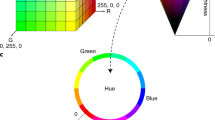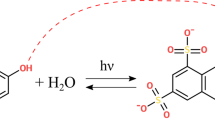Abstract
THE ninhydrin–Schiff reaction of Yasuma and Ichikawa1 has been widely used as a histochemical method for the detection of α-amino-acids2,3 and recently it was applied quantitatively in cytochemistry by Rappay and Törk4. Whereas the detailed mechanism of the reaction has not been completely verified at the histochemical level, there is now fair agreement as to the specificity of the reaction for proteins5. The present experiments endeavour to show that colour production may be markedly affected by the purity of the reagents used.
This is a preview of subscription content, access via your institution
Access options
Subscribe to this journal
Receive 51 print issues and online access
$199.00 per year
only $3.90 per issue
Buy this article
- Purchase on Springer Link
- Instant access to full article PDF
Prices may be subject to local taxes which are calculated during checkout
Similar content being viewed by others
References
Yasuma, A., and Ichikawa, T., J. Lab. Clin. Med., 41, 296 (1953).
Burstone, M. S., Handbuch der Histochemie, 3, 2 (Gustav Fischer Verlag, Stuttgart, 1959).
Braun-Falco, O., Acta Histochem., 2, 264 (1950).
Rappy, Gy., and Törk, I., Acta Morph. Hung. (in the press).
Kasten, F. H., J. Histochem. Cytochem., 10, 769 (1962).
Author information
Authors and Affiliations
Rights and permissions
About this article
Cite this article
RAPPAY, G. Blocking the Ninhydrin – Schiff Reaction with Copper Ions. Nature 200, 274–275 (1963). https://doi.org/10.1038/200274a0
Issue Date:
DOI: https://doi.org/10.1038/200274a0
This article is cited by
-
Comparative and functional analysis of the digital mucus glands and secretions of tree frogs
Frontiers in Zoology (2019)
Comments
By submitting a comment you agree to abide by our Terms and Community Guidelines. If you find something abusive or that does not comply with our terms or guidelines please flag it as inappropriate.



